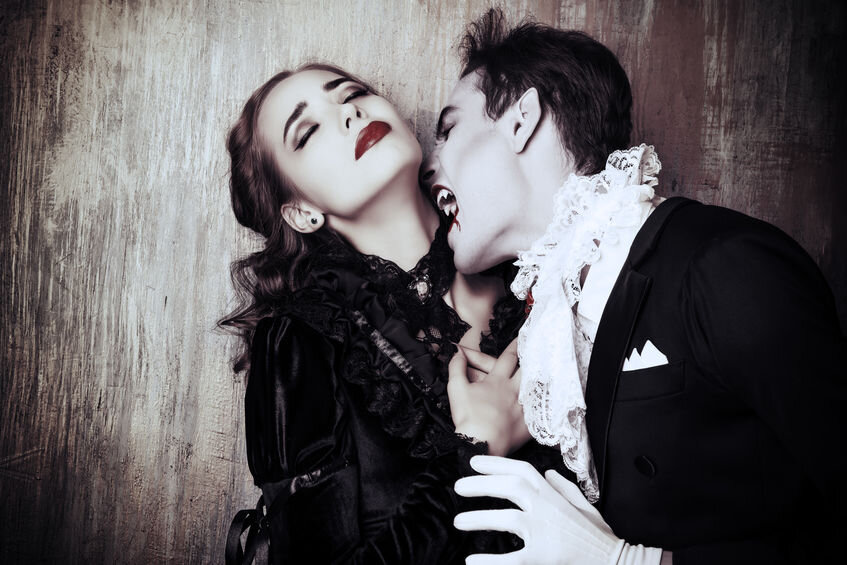Vampires and Werewolves and Mermaids, Oh My! How Many People Fantasize About Sex with Mythical Creatures?
October 25, 2019 by Justin Lehmiller

With Halloween just around the corner, people will soon start dressing up as all kinds of mythical creatures, from werewolves to vampires to mermaids and beyond. Most people who dress up like this for Halloween are probably just doing it for fun—however, others may be doing it because they get a sexual thrill out of it. I mean, if you’re already in costume, this provides a convenient opportunity (or excuse) to try out some unique role play scenarios, or to perhaps reenact your favorite sex scenes from True Blood or Twilight.
So how many people are turned on by the idea of sex with a mythical creature anyway? I surveyed more than 4,000 American adults about their sexual fantasies for my book Tell Me What You Want and the results offer some fascinating insight.
Overall, 33% of my participants said they had fantasized about sex with a mythical creature before. However, women—and, in particular, women who identified as anything other than heterosexual—were more likely to have these fantasies than were men.
Specifically, among heterosexual adults, 28% of women reported these fantasies compared to 19% of men. Likewise, among non-heterosexual adults, 46% of women and 33% of men reported having had these fantasies.
So what kinds of mythical creatures do people find most sexually appealing? Again, it depends on gender.
Among heterosexual women who had fantasized about mythical creatures, 63% of them reported fantasizing about vampires. This was followed by werewolves (9%) and demons (8%), with no other creature registering above 5%.
The numbers for heterosexual men were quite different. While vampires still topped the list (26% had fantasized about them), they were followed closely by demons (17%), mermaids (12%), nymphs (11%), and elves (9%). In other words, while straight women with creature fantasies predominately fantasized about vampires, straight men were far more variable in the creatures they fantasized about.
The pattern was similar when looking at persons who identified as anything other than heterosexual. Among non-heterosexual women, the numbers were: 44% vampires, 13% werewolves, and 10% demons (and nothing else above 5%). For non-heterosexual men, they were: 20% vampires, 18% demons, 12% werewolves, 9% nymphs, 6% elves, 5% mermaids, and 5% fairies.
I should mention that creature fantasies were actually most common among persons who identified as gender non-binary—more than half (56%) of non-binary participants reported such fantasies. Again, vampires were the most fantasized about creature (29%), followed by demons (17%), werewolves (13%), and elves (6%).
Although most of my participants (other than non-binary persons) said they’ve never fantasized about a mythical creature, these fantasies clearly aren’t uncommon. So why do so many people have fantasies of this nature anyway? There are likely a few potential explanations.
For one thing, fantasies about mythical creatures are a novelty—and we know human beings are titillated by the idea of doing new and different things in bed (a phenomenon known as the Coolidge Effect). We tend to grow bored with sexual routines, which is part of the reason we see so much diversity and variability in our sexual fantasies in general.
However, others many have these fantasies simply because they have active imaginations. Indeed, people who are active daydreamers report more sexual fantasies about almost everything, including sci-fi sex scenarios. In other words, creature fantasies are sometimes nothing more than the product of a wandering mind.
Another possibility is that a lot of these mythical creatures have reputations for being somewhat scary, especially vampires, demons, and werewolves. When we see depictions of scary creatures, this induces a sense of fear that creates physiological arousal. And if you happen to have a sexy person playing the creature in a movie or TV show, the fear response can potentially amplify the sexual response. Indeed, this is precisely why we see that strong emotions are often mistaken for sexual attraction.
Yet one additional factor that might play a role in these fantasies is that they speak to some underlying kink, such as an interest in BDSM. For example, in the case of vampires, they’re known for putting their hands on the throat of a victim and biting down on the neck. In other words, there are dominant-submissive and sadomasochistic elements to the idea of sexually interacting with a vampire. In light of this, it shouldn’t be surprising that I see a positive correlation in my data between fantasies about mythical creatures and fantasies about BDSM in general. In other words, the more people fantasize about BDSM, the more they report fantasizing about various creatures.
Of course, other explanations are possible, too. This isn’t an exhaustive analysis of all possible theories. For example, I’m sure Freudian psychologists would have an entirely different take!
That said, when you put all of this together, it’s no surprise that Halloween is a very sexual holiday for many adults.
Want to learn more about Sex and Psychology ? Click here for previous articles or follow the blog on Facebook (facebook.com/psychologyofsex), Twitter (@JustinLehmiller), or Reddit (reddit.com/r/psychologyofsex) to receive updates. You can also follow Dr. Lehmiller on YouTube and Instagram.
Image Credit: 123RF/Andrey Kiselev
You Might Also Like:

Dr. Justin Lehmiller
Founder & Owner of Sex and PsychologyDr. Justin Lehmiller is a social psychologist and Research Fellow at The Kinsey Institute. He runs the Sex and Psychology blog and podcast and is author of the popular book Tell Me What You Want. Dr. Lehmiller is an award-winning educator, and a prolific researcher who has published more than 50 academic works.
Read full bio >

